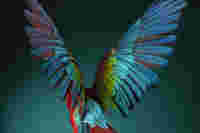We only understand the value of something when we lose it.
We suddenly realize the importance of color in our lives when we watch an old Hollywood movie or an image accidentally comes out of the printer in black and white. Color enriches our existence, both in the real and the proverbial sense. We prefer the vibrant hustle and bustle to the gray of everyday life and appreciate it when someone tells a vivid story instead of painting it in black and white.
There are many different ways of explaining color: physicists, chemists, biologists, and mineralogists all explore the science behind it. Physicians, psychologists, anthropologists, linguists, and archaeologists analyze its functions and interpret its effects. For visual artists, colors are the foundation of their work, and they have been a favorite topic of philosophical research for over 2,500 years. Doctors have tried to use colors to learn more about the relationship between the physical and psychological. At SWAROVSKI OPTIK, we are also fascinated by color and invite you to join us on a stroll through a fascinating world of many different shades.
See Color
First of all, color is a sensory impression conveyed to us by the eye and brain. This doesn’t mean that the objects themselves are colored, but that we only see them as such thanks to incident light, the nature of the eyes, the sensitivity of the receptors, and our perception mechanism. The basic prerequisite for seeing color is light that falls on an object and is reflected by it. Absorption also plays a role, i.e. the part of the wave spectrum that is “swallowed up.” Humans are trichromatic, which means they have three types of cones and can therefore see the colors blue, green, and red. What is commonly referred to as “color” usually means colorants, so pigments or substances that give things their color.

Feathers and Fur
Zoology provides us with two logical explanations: if the animal’s external appearance changes color and shape to adapt to its habitat, then it is primarily for the purposes of camouflage. But if an animal has colorful characteristics, these usually have a reproductive or communicative purpose.
Research into color in the animal kingdom has produced many technical findings. A study by Harvard University ("Structural absorption by barbule microstructures of super black bird of paradise feathers") looked at what is probably the deepest black in the animal kingdom, the plumage of the bird-of-paradise. Researchers suspect that the main purpose of this deep black plumage is to make the rest of the bird’s brightly colored plumage glow even more brightly.
When we’re talking about color, then of course the chameleon is a fascinating creature. Its distinctive color-changing ability inspired Chinese scientists to develop a hydrogel with a butterfly-shaped microstructure, which changes color as it expands. The scientists are hoping to use it to test cardiac drugs, for example a reaction could be reflected by a change in color.




Colors also play an important role in long-range optics. Top-quality binoculars, and spotting scopes are able to provide bright images with excellent color fidelity. This is vital when you are trying to identify the color of fur or feathers. A good example of this is the red fox, whose coat includes several different shades. Its back, outer legs and most of its brush are pale red to rust, while the tip of its tail, belly, neck and inner legs range from white to light gray. Its paws and the back of its ears are black. Besides this “classic” fox coloring, there are many other color variations in the red fox family, such as lighter pelts and white throats, darker pelts and throats, and foxes with black stripes along the spine and shoulders. Such nuances can only be identified with excellent quality optical instruments.
At SWAROVSKI OPTIK, we understand these nuances and their importance. This is what motivates us to constantly improve what is good, in the spirit of our founder Wilhelm Swarovski. With this in mind, we develop products that push the boundaries of what the eye can see – for images that are sharper, clearer, AND more colorful.















